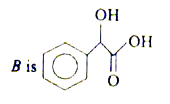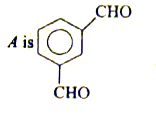A dichloroderivative (A) on treating with KCN followed by acid hydroysis and heating gives a monobasic acid (B) along with liberation of CO2. (B) on heating with liquid ammonia followed by treating with Br2/KOH gives (C ) which on treating with NaNO2 and HCl at low temperature followed by oxidation gives a monobasic acid (D) having molecular mass 74. 'C' in the whole process would be
ethyl amine
propyl amine
tert-butyl amine
cyclopentyl amine.
To solve the problem step by step, let's break down the reactions and transformations mentioned in the question.
Step 1: Identify Compound A
The question states that a dichloroderivative (A) is treated with KCN. A suitable dichloroderivative that fits this description is 1,1-dichloropropane (C3H6Cl2).
Step 2: Reaction with KCN
When 1,1-dichloropropane reacts with KCN, a nucleophilic substitution occurs, resulting in the formation of 1,1-dicyanopropane (C3H4N2).
Step 3: Acid Hydrolysis
The dicyanopropane undergoes hydrolysis in the presence of water (H2O) and an acid (H+). The cyanide groups (-CN) are converted into carboxylic acid groups (-COOH). This results in the formation of dicarboxylic acid, specifically succinic acid (C4H6O4).
Step 4: Heating the Dicarboxylic Acid
When succinic acid is heated, it undergoes decarboxylation, releasing a molecule of carbon dioxide (CO2). This results in the formation of butanoic acid (C4H8O2), which is the monobasic acid (B).
Step 5: Reaction of B with Liquid Ammonia
Butanoic acid (B) is then treated with liquid ammonia (NH3), leading to the formation of an amide, specifically butanamide (C4H9NO).
Step 6: Reaction with Br2/KOH
The butanamide is then treated with bromine (Br2) in the presence of potassium hydroxide (KOH). This reaction leads to the formation of propylamine (C3H9N), which is compound (C).
Step 7: Treatment with NaNO2 and HCl
Propylamine (C) is then treated with sodium nitrite (NaNO2) and hydrochloric acid (HCl) at low temperature. This reaction leads to the formation of propanol (C3H8O).
Step 8: Oxidation of Propanol
Finally, when propanol is oxidized, it results in the formation of propanolic acid (C3H6O2), which is compound (D) with a molecular mass of 74 g/mol.
Conclusion
In summary, the compound C in the whole process is propylamine.
The question states that a dichloroderivative (A) is treated with KCN. A suitable dichloroderivative that fits this description is 1,1-dichloropropane (C3H6Cl2).
When 1,1-dichloropropane reacts with KCN, a nucleophilic substitution occurs, resulting in the formation of 1,1-dicyanopropane (C3H4N2).
The dicyanopropane undergoes hydrolysis in the presence of water (H2O) and an acid (H+). The cyanide groups (-CN) are converted into carboxylic acid groups (-COOH). This results in the formation of dicarboxylic acid, specifically succinic acid (C4H6O4).
When succinic acid is heated, it undergoes decarboxylation, releasing a molecule of carbon dioxide (CO2). This results in the formation of butanoic acid (C4H8O2), which is the monobasic acid (B).
Butanoic acid (B) is then treated with liquid ammonia (NH3), leading to the formation of an amide, specifically butanamide (C4H9NO).
The butanamide is then treated with bromine (Br2) in the presence of potassium hydroxide (KOH). This reaction leads to the formation of propylamine (C3H9N), which is compound (C).
Propylamine (C) is then treated with sodium nitrite (NaNO2) and hydrochloric acid (HCl) at low temperature. This reaction leads to the formation of propanol (C3H8O).
Finally, when propanol is oxidized, it results in the formation of propanolic acid (C3H6O2), which is compound (D) with a molecular mass of 74 g/mol.
In summary, the compound C in the whole process is propylamine.
Topper's Solved these Questions
- AMINES BOOK - NCERT FINGERTPS ENGLISHCHAPTER - AMINES EXERCISE - NCERT Exemplar
24 Videos
- AMINES BOOK - NCERT FINGERTPS ENGLISHCHAPTER - AMINES EXERCISE - NCERT EXEMPLER PROBLEMS
3 Videos
- AMINES BOOK - NCERT FINGERTPS ENGLISHCHAPTER - AMINES EXERCISE - Chemical Reactions
19 Videos
- ALDEHYDES, KETONES AND CARBOXYLIC ACIDSBOOK - NCERT FINGERTPS ENGLISHCHAPTER - ALDEHYDES, KETONES AND CARBOXYLIC ACIDSEXERCISE - Assertion And Reason
15 Videos
- BIOMOLECULESBOOK - NCERT FINGERTPS ENGLISHCHAPTER - BIOMOLECULESEXERCISE - Assertion And Reason
15 Videos
Similar Questions
Benzoic acid is treated with SOCl2 and the product (X) formed is reacted with ammonia to give (Y). (Y) on reaction with Br2 and KOH gives (Z). (Z) in the reaction is
View SolutionGive balanced equations for the following reactions :
Aniline is treated with nitrous acid and HCl at low temperature.
View Solution
Knowledge Check
Compound (A) C8H6O2 on treatment with aq. NaOH followed by acidification gives (B) C3H2O3 which on oxidation gives benzoic acid only:
A B
B C
C D
D
The deamination of Ph2C(OH)CH2NH2 with NaNO2−HCl gives a product (P), which on oxidation gives benzoic acid only. Identify the product (P).
APh−CH2−CH2−PhBPh−O∣∣C−CH2−PhCPh−O∣∣C−O∣∣C−PhDPh−CH2−NH−PhA compound' X' when reacted with PCI5 and then with NH3 gives 'Y'. When 'Y' treated with Br2andKOH produced 'Z'. Z on treatment with NaNO2+HCl at 0°C and then boiling produced ortho-cresol. Compound 'X' is :
Ao-toluic acidBo-chlorotolueneCo-bromotolueneDm-toluic acid
Which of the following will give N2 gas on treatment with nitrous acid (NaNO2+HCl) ?
View SolutionCH3CO2C2H5 on reaction with sodium ethoxide in ethanol gives A, which on heating in the presence of acid gives B compound B is
View Solution1-Ethyl-2-methyl oxirane when treated with C2H5MgBr, followed by hydrolysis gives :
View SolutionWhich of the following compounds reacts with NaNO2 and HCl at 0-4∘C to give alcohol/phenol?
View SolutionThe compound C8H9Cl(A) on treatments with KCN followed by hydrolysis gives C9H10O2(B).Ammonium salt of B on dry distillation yields C.Which reacts with alkaline solution of bromine to gives C8H11N.(D)Another compound E is obtained by the action of nitrous acid on D. E on oxidation gives F which gives the inner anhydride G on heating. The Compound A is :
View Solution
